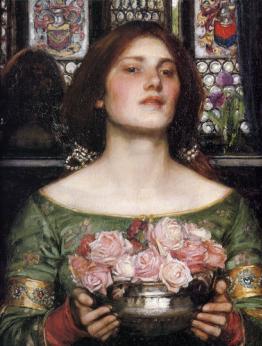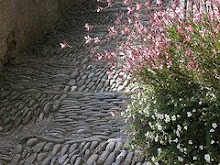
Edward Burne-Jones
Musica, 1877
Musica, 1877
***************
A collaboration between the Museo d’Arte della Citta di Ravenna
and the Ashmolean Museum, Oxford, UK.
The Pre-Raphaelites and the Italian dream:
From Beato Angelico to Perugino,
from Rossetti to Burne-Jones
Museo d'Arte della Città di Ravenna, Ravenna, Italy
through June 6th 2010
http://www.museocitta.ra.it/
LINK to a PDF file with a listing of works in the exhibition.
***************
The Pre-Raphaelites and Italy
Ashmolean Museum, Oxford, UK
15th September 2010 to 5th December 2010
LINK
The exhibition curators are
Claudio Spadoni, Colin Harrison and Christopher Newall.
***************
A collaboration between the Museo d’Arte della Citta di Ravenna
and the Ashmolean Museum, Oxford, UK.
The Pre-Raphaelites and the Italian dream:
From Beato Angelico to Perugino,
from Rossetti to Burne-Jones
Museo d'Arte della Città di Ravenna, Ravenna, Italy
through June 6th 2010
http://www.museocitta.ra.it/
LINK to a PDF file with a listing of works in the exhibition.
***************
The Pre-Raphaelites and Italy
Ashmolean Museum, Oxford, UK
15th September 2010 to 5th December 2010
LINK
The exhibition curators are
Claudio Spadoni, Colin Harrison and Christopher Newall.
***************
A wonderful glimpse of some of the works
that are being shown in Ravenna.
(The Telesanterno commentary is in Italian.)
***************
(The Telesanterno commentary is in Italian.)
***************
Danielle Mitzman, a British freelance journalist based in the north Italian town of Bologna, recently spoke with two of the exhibition curators. She writes, "... a major exhibition, 'The Pre-Raphaelites and the Italian Dream', has opened at MAR, the Museum of Art in the north Italian city of Ravenna. It will run until June before moving to Oxford’s Ashmolean museum in September. Appropriately a joint Anglo-Italian venture, it looks at the connection between the British Pre-Raphaelite movement and the Italian artists – as their name suggests, before Raphael - who inspired them."
** Listen to the interview at this LINK. **
(It is in English.)
(It is in English.)

William Holman Hunt
Tuscan Girl, ca. 1869

Tuscan Girl, ca. 1869
From ItalyTraveller:
"Much more than a dream, Italy was a veritable obsession for the young British artists who went on to found the Pre-Raphaelite Brotherhood. With its "The Pre-Raphaelites and the Italian dream. From Beato Angelico to Perugino, from Rossetti to Burne-Jones", the Ravenna Art Museum (MAR), stages the first ever Italian exhibition devoted to this artistic movement.
It was in the mid 19th century that a group of British artists, guided by William Holman Hunt, rebelled against what they considered formulaic academic mannerism, choosing to take Italian painters from the medieval and pre-renaissance period (before Raphael), as reference. Of the works from this period the Pre-Raphaelites admired the brilliance of the colors used, the intensity of expression, the references to the natural world, and the spontaneous approach to art which they deemed to have been abandoned by the artists who succeeded Raphael.
The exhibition route commences with two rooms containing works by Beato Angelico, Taddeo di Bartolo and Perugino. The exhibition is divided in two sections: one exploring the Pre-Raphaelites interest in Italian painting and art; the other dedicated to the British artists' representations of the country's landscapes and historic buildings. Fascinated by Italy and its history, members of the Pre-Raphaelite Confraternity attempted to direct British painting towards more authentic and less conventional subject matter, far removed from the cliché imposed by the academies. Although, today, the works of the Pre-Raphaelites appear anything but revolutionary or ground-breaking, at the time of their creation, they provoked scandal in Victorian society, to such an extent that they are thought by many to represent the first avant-garde movement in art.
One of the founders of the Pre-Raphaelite movement was Dante Gabriel Rossetti, son of an Italian immigrant, who chose the works of Dante Alighieri as one of the principal themes of his artistic discourse. The exhibition includes a series of splendid paintings by Rossetti and other, lesser known artists, inspired by the Divine Comedy and the life of Dante. Ample space is dedicated to other themes dear to the Pre-Raphaelites, such as that of the woman destroyed by unrequited, tragic or adulterous love."
It was in the mid 19th century that a group of British artists, guided by William Holman Hunt, rebelled against what they considered formulaic academic mannerism, choosing to take Italian painters from the medieval and pre-renaissance period (before Raphael), as reference. Of the works from this period the Pre-Raphaelites admired the brilliance of the colors used, the intensity of expression, the references to the natural world, and the spontaneous approach to art which they deemed to have been abandoned by the artists who succeeded Raphael.
The exhibition route commences with two rooms containing works by Beato Angelico, Taddeo di Bartolo and Perugino. The exhibition is divided in two sections: one exploring the Pre-Raphaelites interest in Italian painting and art; the other dedicated to the British artists' representations of the country's landscapes and historic buildings. Fascinated by Italy and its history, members of the Pre-Raphaelite Confraternity attempted to direct British painting towards more authentic and less conventional subject matter, far removed from the cliché imposed by the academies. Although, today, the works of the Pre-Raphaelites appear anything but revolutionary or ground-breaking, at the time of their creation, they provoked scandal in Victorian society, to such an extent that they are thought by many to represent the first avant-garde movement in art.
One of the founders of the Pre-Raphaelite movement was Dante Gabriel Rossetti, son of an Italian immigrant, who chose the works of Dante Alighieri as one of the principal themes of his artistic discourse. The exhibition includes a series of splendid paintings by Rossetti and other, lesser known artists, inspired by the Divine Comedy and the life of Dante. Ample space is dedicated to other themes dear to the Pre-Raphaelites, such as that of the woman destroyed by unrequited, tragic or adulterous love."

John Ruskin
Italian Village, 1845
(not included in the exhibit)
LINK

Italian Village, 1845
(not included in the exhibit)
LINK
"The passion for Italy and its artistic heritage, which animated these artists, emerges in the works of John Ruskin who, during his many journeys through Italy studied with attention the artistic treasures of the Italian peninsula, recording them in the form of meticulously accurate drawings in the conviction that, in this way, he would somehow be able to save them from degradation and preserve their beauty. Ruskin even financed the journeys to Italy of a series of artists and students from Oxford University, so that they could follow his example and realize drawings and paintings of all the most beautiful Italian monuments. The resulting collection of works is one of the most interesting aspects of the Ravenna exhibition. The exhibition concludes with Edward Burne-Jones' sketches of the mosaics realized for Rome's Church of San Paolo dentro le Mura, mosaics inspired by the Byzantine masterpieces still visible in the basilicas of Ravenna." (Courtesy: ItalyTraveller)

Dante Gabriel Rossetti
Dante Designs an Angel on the First Anniversary
of the Death of Beatrice, 1853
Pietro Vannucci (Perugino)
A video by Ricardo G. Silveira
Dante Designs an Angel on the First Anniversary
of the Death of Beatrice, 1853
From an article by Rachel Spence about the exhibit: "Intensely romantic and spiritual, yet rooted in the language of the common man, Dante’s verses furnished the ideal subject matter. Rossetti, who was also a poet himself, both translated and illustrated many of the Tuscan’s verses. Of several watercolours on show here, the most historically significant is the earliest – “Dante Designs an Angel on the First Anniversary of the Death of Beatrice” (1853) – which brought the young painter to the attention of Ruskin for the first time. The critic hailed it as “the most perfect piece of Italy I have ever seen in my life”." LINK
(*Update April 13th ... another article about the exhibit. LINK)
Some works by Beato Angelico and Perugino.
Beato Angelico
A Rome Reports TV News Agency video from April 2009
Some works by Beato Angelico and Perugino.
Beato Angelico
A Rome Reports TV News Agency video from April 2009
Pietro Vannucci (Perugino)
A video by Ricardo G. Silveira


























No comments:
Post a Comment